Zehir-ed-Din Muhammad Babur was
born on February 14, 1483 in Andijan in Farghana. This place is in Uzbekistan,
a Central Asian Republic of the Union of Soviet Socialist Republics. His father
Umar Sheikh Mirza, a Turk and a descendant of Timur was the ruler of Farghana.
His mother Khutlugh Nigar KhAnum was a descendant of Chingiz Khan. So both from
the father's and mother's side he could claim an ancestry of unique
distinction.
FAR
GHANA
Babur spent the first eleven
years and a quarter of his life in Farghand while his father was busy extending
the frontiers of his small principality. He learnt his mother tongue Turki as
well as Persian and also practised archery and horse riding. His father died in
1494 in the fort of Akshi due to the collapse of a pigeon house where he was
feeding pigeons.
Babur succeeded his father as
ruler of Farghana at the age of twelve. His rule of Far-ghana for twenty one
years was a period of turmoil. His chief ambition in this period was to conquer
the prestigious city of Samarkand built by his ancestor Timur, which was a
great cultural centre of the Islamic world. This brought him into conflict with
his uncles; Ahmad Miranshahi and Mahmud ChaghatAi, and later on with Shaibani
Khan, the leader of Mongolo-Turkish tribe called the Uzbegs. Samarkand was a
city of gardens dotted with mausoleums, including Gur-Amir, the tomb of Timur
ornamented with magnificent blue tiles. It also had the observatory of Ulugh
Beg, which contained a gigantic quadrant with which he compiled his famous
astronomical tables.
Baur undertook two campaigns to
conquer Samarkand. In 1497 after a siege of seven months he captured Samarkand.
During his stay in Samarkand the nobles in Farghana taking advantage of his
absence handed over a part of the state territory to his younger brother
Jahangir. In February 1498 Babur left Samarkand to reconquer Farghand. He could
not retrieve the lost territory and also lost Samarkand. He was forced to spend
the winter in the fort of Khujand, and supported himself as well his soldiers
by raiding the neighbouring villages. This was a period of great misery for
him, but he kept up his courage.
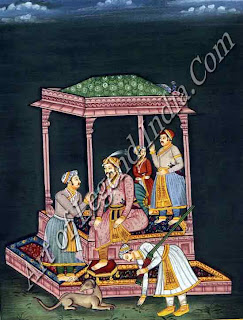 Babur won back the lost
territory from Jahangir who was supported by Ahmad Tambal when he defeated them
at Khuban in 1499. During this year he was married to Ayisha-Sultan Begam. She
did not attract him much and he mentions that out of modesty and bashfulness,
he used to see her only occasionally. In fact, his indifference to his wife was
due to the fact that he was infatuated with a youth named Baburi.
Babur won back the lost
territory from Jahangir who was supported by Ahmad Tambal when he defeated them
at Khuban in 1499. During this year he was married to Ayisha-Sultan Begam. She
did not attract him much and he mentions that out of modesty and bashfulness,
he used to see her only occasionally. In fact, his indifference to his wife was
due to the fact that he was infatuated with a youth named Baburi.
In 1500 Babur again attacked
Samarkand. Shaibani Khan who was then the ruler of Samarkand was camping in one
of the gardens outside the city walls. Babur's soldiers scaled the city walls
and with the co-operation of the inhabitants, who were disgusted with the
savage rule of Shaibani Khan, occupied the city. After some months Shaibani
Khan returned with a large force and besieged the city. Supplies were cut off,
the garrison was starved and Baur was forced to surrender. He was also
compelled to give his elder sister Khanzada in marriage to Shaibani Khan. One
night accompanied by his mother and a few loyal followers he escaped from
Samarkand.
This was another dark period
for Babur and he sought refuge with his uncles in the area around Tashkent.
Shaibani Khan not only had Samarkand, but had also captured a large slice of
territory of Farghana. In 1504 Babur was in a desperate situation, and only a
handful of loyal soldiers remained with him.
KABUL
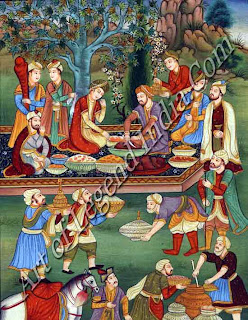 When in 1504 everything
appeared to have been lost, Babur with his three hundred and odd followers
crossed the Hindu Kush in a snow storm, stumbled into Kabul and made him-self
the master of a principality named after that city. Thus began the second phase
of his career. For the next twenty-two years, he was the king of Kabul which
roughly corresponded to the modern Afghanistan and included Badakshan. From
1504 to 1513, with Kabul as his base, Babur again tried to conquer Samarkand.
This ambition was fulfilled almost absolutely in October 1511 when he entered
that city "in the midst of such pomp and splendour as no one has ever
heard of before or ever since." Babur's dominions now reached their widest
extent: from Tashkent and Sairam on the borders of the deserts of Tartary, to
Kabul and Ghazni and the Indian frontier. It included within its boundaries
Samarkand, Bokhara, Hissar, Kunduz and Farghana. But this glory was as
shortlived as it was great. Uzbeg chiefs from whom Babur had snatched Samarkand
in October 1511 returned to attack the city in June 1512 and inflicted a
crushing defeat on Babur. Babur was forced to flee from one part of his
dominions to another. He lost everywhere and finally returned to Kabul early in
1513.
When in 1504 everything
appeared to have been lost, Babur with his three hundred and odd followers
crossed the Hindu Kush in a snow storm, stumbled into Kabul and made him-self
the master of a principality named after that city. Thus began the second phase
of his career. For the next twenty-two years, he was the king of Kabul which
roughly corresponded to the modern Afghanistan and included Badakshan. From
1504 to 1513, with Kabul as his base, Babur again tried to conquer Samarkand.
This ambition was fulfilled almost absolutely in October 1511 when he entered
that city "in the midst of such pomp and splendour as no one has ever
heard of before or ever since." Babur's dominions now reached their widest
extent: from Tashkent and Sairam on the borders of the deserts of Tartary, to
Kabul and Ghazni and the Indian frontier. It included within its boundaries
Samarkand, Bokhara, Hissar, Kunduz and Farghana. But this glory was as
shortlived as it was great. Uzbeg chiefs from whom Babur had snatched Samarkand
in October 1511 returned to attack the city in June 1512 and inflicted a
crushing defeat on Babur. Babur was forced to flee from one part of his
dominions to another. He lost everywhere and finally returned to Kabul early in
1513.
The reason for Babur's
discomfiture in the second half of 1512 lay in his understanding with Shah
Ismael Safavi of Persia for the capture of Samarkand. For the Shah's support
Babur had agreed to hold the Samarkand kingdom as his vassal, become a convert
to the Shia faith, adopt all its symbols, and to impose the Shia creed on the
orthodox Sunni subjects of the conquered kingdoms. This unprincipled compromise
made Baur extremely unpopular with his Sunni subjects and enabled the Uzbeg
chiefs to stage a come back at Samarkand.
In Kabul, Baur found time and
leisure to indulge in his favourite hobby of gardening. Apart from Beigh-i-wafa
ten gardens are mentioned as made by him viz., the Shahr-ãrã (Town-adorning),
which contained very fine plane-trees, the Char-bagh, the Bagh-i-jalau-khanei,
the Aarta-biigh (Middle-garden), the Saurat-bagh, the Bligh-i-inahtab
(Moonlight-garden), the Bilgh-i-ahu-khana (Garden-of-the-deer-house), and three
smaller ones. In these gardens he held his feasts and drink parties.
HINDUSTAN
Babur now diverted his restless
ambition to India. To be sure of success he took one of the most important
steps of his life. Profiting from the example of Shah Ismael, he began building
up effective artillery and sometimes between 1514 and 1519 secured the services
of an Ottoman Turk. Named Ustad Ali, who became his master of ordnance.
Having, thus, strengthened his
fighting machine a great deal, Babur started a probe into Hindustan. Early in
1519, he went in for what is called his first expedition in India. He stormed
Bdjaur which offered a spirited resistance but was ultimately forced to accept
defeat before Babur's artillery. Babur massacred the population of the city to
avenge the losses he had suffered as a result of the unexpected resistance of
the people of Bajaur, but more so to warn the people of other cities of the
fate awaiting them if they chose to resist his army. His purpose was well
served. When he reached Bhera on the Jhelum, no resistance was offered. That
encouraged him to claim for the first time entire north-western India on the
plea that it once formed part of Timur's empire. Perhaps he would have followed
this claim with a deeper penetration in the interior of the Punjab if he was
not told that back home a conspiracy was being hatched against him.
In September 1519 Babur invaded
Hindustan again. This was his second expedition to Hindustan. He marched
through Khyber, subdued the turbulent Yusafzai tribe and provisioned the
Peshawar fort for future operations. He was forced to give up his ambition of
going further at this stage because of disturbing news from Badakshan.
After taking possession of
Badakshan, Babur marched into India on his third expedition early in 1520. As
in his first expedition, now also he first went to Bajaur and from there
proceeded to Ehera. But this time he did not stop at Bhera. Subduing the
recalcitrant Afghan tribes, he proceeded to Sialkot which submitted without
striking a blow. When he moved on to Saiyidpur, he met a tough resistance but
ultimately succeeded in subduing the place. Perhaps with the same object in
view that had motivated his massacre of the people of Bajaur two years ago, he
mercilessly massacred the people of Saiyidpur. That could have been a prelude
to his moving into Lahore but on hearing that the ruler of Kandahar, Shah Beg Khdn
was marching on Kabul, he hastily returned to Kabul.
Babur did not invade India for
the next four years. Between 1520 and 1522 he was busy subduing Shdh Beg. In
the following two years he strengthened his position in Kandahar. But he had by
no means given up the Indian project. He further improved his artillery by
securing the services of Mustafa..., another Turkish expert.
Bdbur embarked on his fourth
expedition to India in 1524 on the invitation of Daulat Khan Lodi, the powerful
Wazir of the Punjab. He marched into the valleys of the Jhelum and the Chenab,
and became the master of both Lahore and Dipalpur. Much to the disappointment
of atulat Khan, who had invited Babur to serve his political ends, Babur now
proclaimed the major part of what subsequently became the Lahore and Multan
subas of the Mughal Empire as part of his Kabul kingdom. He appointed his own
governors over these areas and offered Daulat Khan the petty governorship of
the Jullundur Doab. Little wonder that no sooner Babur went back, Daulat Khan
raised a big army to fight him.
Babur invaded India again in
November 1525. This was his fifth invasion of India. Because he anticipated a
tough resistance from Daulat Khan and also a sharp conflict with Sultan Ibrahim
Lodi, he now went to India with "the largest army he had ever led into
Hindustan." Daulat Khan's army melted away at his approach but with
Ibrahim, Babur had to fight the most crucial battle of his life on 21 April,
1526, the First Battle of Panipat.
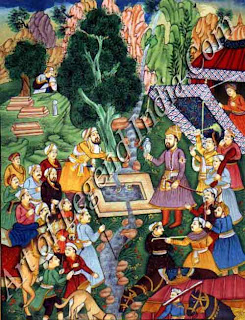 The First Battle of Panipat
began the last phase of Babur's life. It is well known in all its details to
the students of Indian history and may be briefly told. Babur states, "I
placed my foot in the stirrup of resolution, and my hand on the reins of
confidence in God, and marched against Sultan Ibrahim, the son of Sultan
Sikandar, the son of Sultan Bahlol Lodi Afghan, in whose possession the throne
of Delhi and the dominions of Hindustan at that time were; whose army in the
field was said to amount to a hundred thousand men, and who, including those of
his Amirs, had nearly a thousand elephants." For the first time in the
history of India artillery was used in warfare. Ustad Kuli Khan was the master
gunner of Babur. Indian elephants fled in terror on hearing the sound of artillery,
trampling Ibrahim's soldiers. By mid-day the battle was over. Ibrahim Lodi, lay
dead with 30,000 of his soldiers.
The First Battle of Panipat
began the last phase of Babur's life. It is well known in all its details to
the students of Indian history and may be briefly told. Babur states, "I
placed my foot in the stirrup of resolution, and my hand on the reins of
confidence in God, and marched against Sultan Ibrahim, the son of Sultan
Sikandar, the son of Sultan Bahlol Lodi Afghan, in whose possession the throne
of Delhi and the dominions of Hindustan at that time were; whose army in the
field was said to amount to a hundred thousand men, and who, including those of
his Amirs, had nearly a thousand elephants." For the first time in the
history of India artillery was used in warfare. Ustad Kuli Khan was the master
gunner of Babur. Indian elephants fled in terror on hearing the sound of artillery,
trampling Ibrahim's soldiers. By mid-day the battle was over. Ibrahim Lodi, lay
dead with 30,000 of his soldiers.
Soon after the battle of
Panipat, Babur proclaimed himself as the Padshah of Hindustan with his
headquarters at Agra. At Agra he laid a garden near the Jumna. During the heat
of summer he sought refuge in this garden.
Babur defeated Rana Sangha in
the battle of Khanna on 16 March, 1527, captured the fort of Chanderi on 29
January, 1528, and humbled the Afghans in the battle of Gogra on 6 May, 1529.
Now he was master of northern India. He died on 26 December, 1530 at the age of
forty-seven years, ten months and eleven days after an illness of more than six
months. Thus ended a stormy career which culminated in the founding of Mughal
dynasty which enormously enriched the cultural life of India. The Mughals gave
India new architecture, terraced gardens with flowing water, and a new style of
painting.
 Babur won back the lost
territory from Jahangir who was supported by Ahmad Tambal when he defeated them
at Khuban in 1499. During this year he was married to Ayisha-Sultan Begam. She
did not attract him much and he mentions that out of modesty and bashfulness,
he used to see her only occasionally. In fact, his indifference to his wife was
due to the fact that he was infatuated with a youth named Baburi.
Babur won back the lost
territory from Jahangir who was supported by Ahmad Tambal when he defeated them
at Khuban in 1499. During this year he was married to Ayisha-Sultan Begam. She
did not attract him much and he mentions that out of modesty and bashfulness,
he used to see her only occasionally. In fact, his indifference to his wife was
due to the fact that he was infatuated with a youth named Baburi.  When in 1504 everything
appeared to have been lost, Babur with his three hundred and odd followers
crossed the Hindu Kush in a snow storm, stumbled into Kabul and made him-self
the master of a principality named after that city. Thus began the second phase
of his career. For the next twenty-two years, he was the king of Kabul which
roughly corresponded to the modern Afghanistan and included Badakshan. From
1504 to 1513, with Kabul as his base, Babur again tried to conquer Samarkand.
This ambition was fulfilled almost absolutely in October 1511 when he entered
that city "in the midst of such pomp and splendour as no one has ever
heard of before or ever since." Babur's dominions now reached their widest
extent: from Tashkent and Sairam on the borders of the deserts of Tartary, to
Kabul and Ghazni and the Indian frontier. It included within its boundaries
Samarkand, Bokhara, Hissar, Kunduz and Farghana. But this glory was as
shortlived as it was great. Uzbeg chiefs from whom Babur had snatched Samarkand
in October 1511 returned to attack the city in June 1512 and inflicted a
crushing defeat on Babur. Babur was forced to flee from one part of his
dominions to another. He lost everywhere and finally returned to Kabul early in
1513.
When in 1504 everything
appeared to have been lost, Babur with his three hundred and odd followers
crossed the Hindu Kush in a snow storm, stumbled into Kabul and made him-self
the master of a principality named after that city. Thus began the second phase
of his career. For the next twenty-two years, he was the king of Kabul which
roughly corresponded to the modern Afghanistan and included Badakshan. From
1504 to 1513, with Kabul as his base, Babur again tried to conquer Samarkand.
This ambition was fulfilled almost absolutely in October 1511 when he entered
that city "in the midst of such pomp and splendour as no one has ever
heard of before or ever since." Babur's dominions now reached their widest
extent: from Tashkent and Sairam on the borders of the deserts of Tartary, to
Kabul and Ghazni and the Indian frontier. It included within its boundaries
Samarkand, Bokhara, Hissar, Kunduz and Farghana. But this glory was as
shortlived as it was great. Uzbeg chiefs from whom Babur had snatched Samarkand
in October 1511 returned to attack the city in June 1512 and inflicted a
crushing defeat on Babur. Babur was forced to flee from one part of his
dominions to another. He lost everywhere and finally returned to Kabul early in
1513.  The First Battle of Panipat
began the last phase of Babur's life. It is well known in all its details to
the students of Indian history and may be briefly told. Babur states, "I
placed my foot in the stirrup of resolution, and my hand on the reins of
confidence in God, and marched against Sultan Ibrahim, the son of Sultan
Sikandar, the son of Sultan Bahlol Lodi Afghan, in whose possession the throne
of Delhi and the dominions of Hindustan at that time were; whose army in the
field was said to amount to a hundred thousand men, and who, including those of
his Amirs, had nearly a thousand elephants." For the first time in the
history of India artillery was used in warfare. Ustad Kuli Khan was the master
gunner of Babur. Indian elephants fled in terror on hearing the sound of artillery,
trampling Ibrahim's soldiers. By mid-day the battle was over. Ibrahim Lodi, lay
dead with 30,000 of his soldiers.
The First Battle of Panipat
began the last phase of Babur's life. It is well known in all its details to
the students of Indian history and may be briefly told. Babur states, "I
placed my foot in the stirrup of resolution, and my hand on the reins of
confidence in God, and marched against Sultan Ibrahim, the son of Sultan
Sikandar, the son of Sultan Bahlol Lodi Afghan, in whose possession the throne
of Delhi and the dominions of Hindustan at that time were; whose army in the
field was said to amount to a hundred thousand men, and who, including those of
his Amirs, had nearly a thousand elephants." For the first time in the
history of India artillery was used in warfare. Ustad Kuli Khan was the master
gunner of Babur. Indian elephants fled in terror on hearing the sound of artillery,
trampling Ibrahim's soldiers. By mid-day the battle was over. Ibrahim Lodi, lay
dead with 30,000 of his soldiers. 
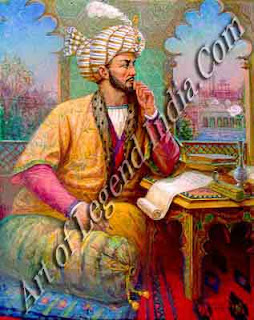
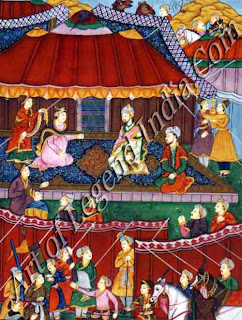
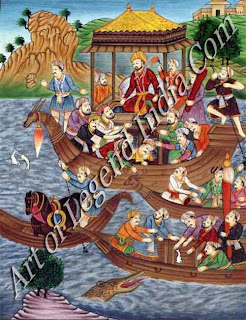










0 Response to "Zehir-ed-Din Muhammad Babur"
Post a Comment